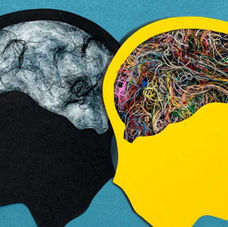top of page


Latest Publications












Browse Our Content
With a focus on clinical and biomedical coverage, our medical article bank seeks to break down complex subjects across over 20 disciplines, including genomics, hematology, and neurology.
Our health page maintains a broad scope with an emphasis on lifestyle. It includes topics such as diet, exercise, public health, mental health, and other medical topics.
Read about our recent campaign to help reduce prescription waste!

Feature of the Month
We select spotlights based on your feedback. Love an article you read? Let us know!

Covered Fields










Real World Evidence 101
Image by Freepik Real world evidence (RWE) is transforming the current healthcare landscape. By the use of robust data analytics tools, data collected through routine clinical practice is converted into RWE. The insights and evidence generated are valuable in guiding healthcare decision making for better patient outcomes. What is Real World Data? Real World Data (RWD) is all patient data collected in everyday clinical practice through a variety of sources. The U.S. Food and D
Priya Kumar
6 days ago3 min read


Re-shaping the Gut, Re-shaping the Body?: Gut Microbiota and its Influence on Obesity
Obesity is a public-health challenge with complex causes beyond simple caloric imbalance. Emerging evidence points towards the gut microbial ecosystem - known as the gut microbiota - as a biological factor influencing energy homeostasis, metabolism and inflammation. The interactions between diet, environment and microbiota may in part help explain why many individuals may struggle to either lose weight or maintain weight loss. Recent advances in our understanding of gut micro
Samantha Sutherland
6 days ago4 min read


From Clean eating to Orthorexia: The slippery slop of restraint.
You're on Instagram or TikTok, there are countless reels that are promising to make you a healthier, better version of yourself, one meal-prepped salad, green smoothie, or jar of overnight oats at a time. Influencers proudly promote "approved" ingredients, list things they've taken out, and demonstrate "clean eating" practices. "You are what you eat" is one of the most common captions. On the surface, this appears to be motivating. Who wouldn't want to feel more energised, ea
Simran Kaur Bansal
3 days ago6 min read


Nourish to Flourish: Food as Medicine
The prevalence of chronic illness has steadily increased over the past few decades, with roughly 90% of the annual healthcare cost spent on chronic illness according to the American Heart Association. Doctors and other healthcare providers are now looking at diet as a way to complement modern medicine in an effort to treat or even prevent certain chronic conditions. Chronic conditions such as obesity, type 2 diabetes, high blood pressure, high cholesterol, chronic kidney dise
meredithchubb
4 days ago4 min read


Psychobiotics: A Revolutionary Shift In Treatment for Mental Health
Rachelle DiMedia Have you ever experienced “butterflies” in your stomach before a big event? That’s your gut and brain communicating—and scientists are discovering this connection is more profound than they previously thought. Depression and anxiety present a significant burden on society and those who suffer from them. They are a leading cause of disability in the U.S., affecting not only the individual but also their loved ones. There is a growing need to discover thera
Rachelle DiMedia
4 days ago6 min read


The Race to Bring Psychedelics to Psychiatry
Steve Jobs was open about how using LSD shaped his worldview and enhanced his creativity. Spiritual leader Ram Das, who has millions of followers postmortem, attributed his spiritual awakening to psychedelics. Now pharmaceutical companies around the world are racing to bring these types of drugs to your medicine cabinet. In 2023, the FDA legitimized the potential therapeutic use of psychedelics by issuing “ first draft guidance ” for clinical trials. (1) And in 2024, the FDA
Mali Arwyn
5 days ago2 min read


AI and Pediatric Mental Health: Can Technology Support the Next Generation?
The psychological issues among children and adolescents are getting progressively worse. Up to 20% of children and adolescents worldwide are struggling with mental illnesses, but most of them never get the help they need. The disparity is exacerbated by stigma, a lack of child psychiatrists, and restricted access to care, particularly in low- and middle-income nations. With its ability to provide early detection, digital interventions, and individualized care, artificial
kiralksf
Dec 113 min read


Preventative Interventions After Your Baby Is Born
After your precious baby is born and you have had your golden hour with them, your healthcare team will start performing routine newborn procedures. If you are in a hospital setting, these procedures typically include three preventative interventions: erythromycin eye ointment, vitamin K, and the first dose of the hepatitis B vaccine. This article will discuss what each of these interventions is intended to prevent. Erythromycin Eye Ointment Erythromycin is an antibiotic that
janekbrainard
Nov 243 min read


Understanding Nausea and Vomiting after Surgery
Jennifer Navarro MSN, RN, NPD-BC A Simple Guide for Patients Introduction Have you ever wondered why you might feel sick to your stomach...
jennifernavarro292
Sep 43 min read


What's Your Count?
Stryker Ipad device used to scan sponges in/out used in the perioperative setting Importance of Surgical Counts As a perioperative nurse,...
Ginny Yelverton BSN-RN
Jul 243 min read


When the Air Turns Toxic: The Rising Toll of Wildfire Smoke on Global Health
In recent years, the world has watched skies turn orange from California to Canada, Australia to Greece. The smell of burning forests, once a distant problem, now drifts into cities thousands of miles from the flames. Wildfire smoke has become one of the most visible and dangerous signs of a warming planet and it’s reshaping the way we think about air, health, and preparedness. A Growing Global Threat Wildfires are not new, but their frequency, size, and intensity have increa
Nicole Winship
Dec 114 min read


Pulmonary Failure : What is it ? Why is it so dangerous ?
Pulmonary Failure Pulmonary failure (respiratory failure) happens when the lungs cannot provide sufficient oxygen to the body or cannot remove carbon dioxide properly . This can lead to serious complications if let untreated including brain damage , organ failure and even death . Due to this pulmonary failure is considered a medical emergency . How does Pulmonary Failure develop ? Pulmonary failure can develop due to many different illnesses or injuries such as: Severe lun
krishgupta0907
Dec 12 min read


The End of Reading Glasses? Inside the Eye Drops Revolution for Aging Eyes
What is Presbyopia? Presbyopia, often called “age-related farsightedness”, is a natural part of aging that is caused by the gradual loss of the eye’s ability to focus on near objects, like when reading or looking at a phone. It occurs because the crystalline lens inside the eye becomes stiffer with age, and the surrounding muscles lose some elasticity. This affects nearly everyone over 40, impacting over a billion people worldwide. For decades, the main solutions have been re
Sepideh Cheheltani
Dec 123 min read


Difficulty Seeing at Night? A Symptom Guide to Nyctalopia
Night blindness (nyctalopia) is the inability to see well in dim light or darkness, making daily tasks dangerous. It's not a disease itself, but a symptom of an underlying problem.
Yoon Shwe Yi Han
Nov 122 min read


Does Paracetamol Cause Autism in Pregnancy?
Recent information from studies linking paracetamol/acetaminophen (Tylenol) use in pregnancy to autism disorders have popularised on the internet massively in August/September 2025, which has caused nationwide concern about mothers taking these painkillers when they are expected to have a baby. The information surrounding this comes from studies that are observational cohort studies, reporting statistical association between paracetamol exposure in pregnancy and increased ris
Abigail Simpson
Dec 14 min read


Paracetamol in pregnancy: myths demystified
Paracetamol (acetaminophen), reduces fever and relieves mild to moderate pain. It is a widely available over-the-counter drug sold under various brand names, including Tylenol and Panadol. Because pregnant women often face limits on what medications are considered “safe,” paracetamol is typically recommended as the first-line option when something is needed. However, over the past years, there has been increasing scientific scrutiny about whether paracetamol might carry ri
L.Hunter
Nov 304 min read
bottom of page













































